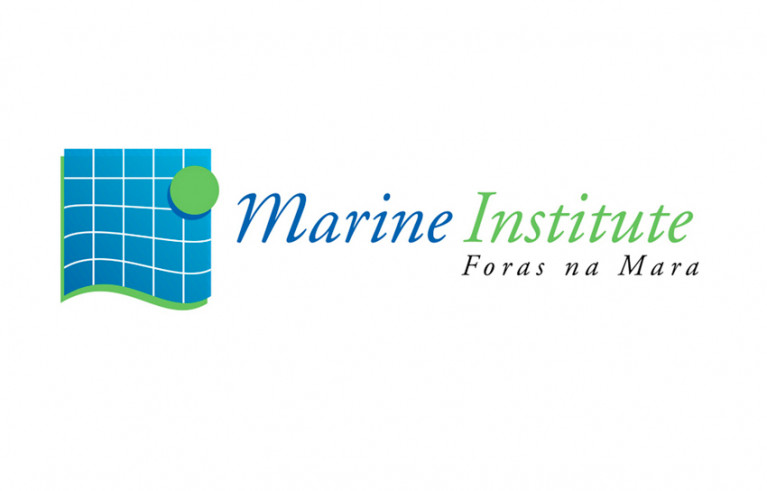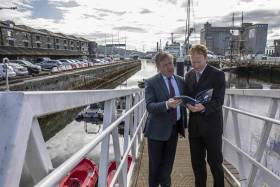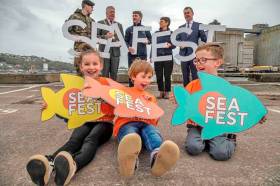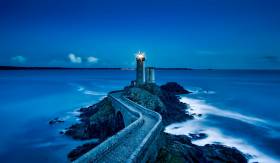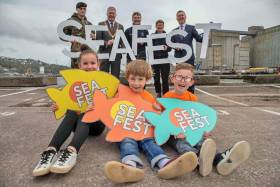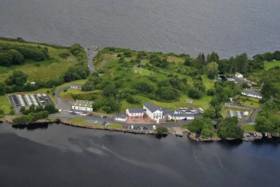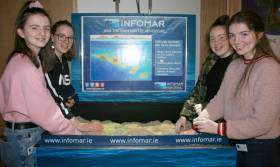Displaying items by tag: Our Ocean Wealth
Ocean Energy Is Greatest Opportunity For Growth Of Blue Economy, Survey Says
Ocean energy is the greatest opportunity for the growth of Ireland’s maritime or ‘Blue’ economy, according to a new survey produced as part of the Our Ocean Wealth Summit.
As the Irish Examiner reports, the survey commissioned by the Marine Institute and PwC says more than 80% of leading voices in the maritime sector are “confident in its future growth potential”, in the words of PwC partner Declan McDonald.
Apart from offshore energy developments in wave and wind power, the survey highlights potential in maritime tourism, aquaculture, sea fisheries, biotechnology and shipping.
The Irish Examiner has much more on the story HERE.
Former US Secretary of State John Kerry has called for immediate action to move to decarbonisation to manage climate change.
The former US senator and presidential candidate was delivering the first keynote address of the Our Ocean Wealth Summit in Cork City Hall on Sunday 9 June.
In his address, Kerry was passionate about the state of our oceans, and he delivered a hard-hitting speech that criticised governments for not being transparent about climate change and called for urgent implementation of better energy policy.
Sponsored by PwC, the Ocean Wealth Summit was moderated by Marine Institute chief executive Dr Peter Heffernan featured contributions from a number of national and international government officials.
Tánaiste Simon Coveney and Marine Minister Michael Creed were actively engaged in discussion with representatives from Small Island Developing States (SIDS) on how governments could work together to broker key solutions to implement the UN Sustainable Development Goals.
Later at the summit, and together with Minister of State for Housing and Urban Renewal, Damien English, they launched the State’s draft Marine Planning Policy Statement.
This is being touted as “a true recognition of the importance of a fully integrated marine planning system across all aspects of marine forward planning, marine development management and marine planning enforcement”.
The Marine Planning Policy Statement is now open for public consultation until noon on Friday 9 August.
Sunday afternoon sessions at the summit were moderated by Dr Tara Shine. These led with a keynote address by European Parliament First Vice President Mairéad McGuinness on the work that Europe is doing and needs to do to effect decarbonisation and promote a greener, cleaner society to support the oceans health and wealth.
Also speaking at the summit was Ireland’s Youth Ambassador to the Oceans, Alicia O’Sullivan, who delivered a powerful address to motivate people in Ireland to see the impact of decisions at local level, which have national and global impact.
The 17-year-old echoed the words of climate activist Greta Thurnberg when she said that urgent action is required as the “house is on fire”.
Thousands Flock To This Year’s SeaFest in Cork
Ireland’s largest free family-friendly maritime celebration attracted thousands of visitors to the port and city of Cork this past weekend.
Cork was transformed into a giant interactive ‘sea world’ for the three days of SeaFest 2019, and the port was awash with non-stop activities and entertainment for all ages.
Visitors to the Marine Institute’s Wild Atlantic Theatre were treated to exciting talks and shows with award-winning wildlife cameraman Doug Allan, filmmaker Ken O’Sullivan and Met Éireann’s head of forecasting Evelyn Cusack.
Ireland’s maritime history was also in focus with a seminar on the antiquity and sustainability of curraghs, as Tom MacSweeney writes.
And the side of the R&H Hall building in Cork Harbour was transformed with an enormous depiction of the ‘Real Map of Ireland’ which takes into account the State’s significant seabed territory.
All the events during SeaFest were free for festival-goers. There were open tours available on a number of vessels in the ship-filled harbour including State research vessel RV Celtic Explorer — fresh off its annual ocean climate research survey to collect high-quality oceanographic data for the Atlantic Ocean Observing System.
The festival, which was held in Galway for the last few years, concluded yesterday (Monday 10 June) with the Ocean Wealth Summit which featured special guests John Kerry, the former US Secretary of State, and the presidents, foreign ministers or UN ambassadors of 31 small island developing states.
SeaFest 2019 also saw the official launch of EurofleetsPlus, the programme to facilitate access to the largest advanced research vessel fleet across Europe, Greenland, the USA and Canada, Bermuda and New Zealand — providing a significant increase in ship-time at sea.
The programme will now move towards its competitive call phase, including SEA (ship-time and marine equipment application) which will have an ‘Ocean’ call, due to open this month, and a ‘Regional’ call in September.
On Course As Ireland’s Ocean Economy to Achieve 2020 Target
The Socio-Economic Marine Research Unit (SEMRU) at NUI Galway has released its latest update on the performance of Ireland’s Ocean Economy.
Coinciding with the Our Ocean Wealth Summit and the Government’s Annual Review of its Integrated Marine Plan – Harnessing Our Ocean Wealth, the report presents a complete and comparable profile across thirteen marine related industries in Ireland.
The update shows that Ireland’s ocean economy has a turnover of €6.2 billion, with a direct economic contribution, as measured by GVA, of €2.2 billion or 1.1% of GDP. Taking into account indirect GVA generated from ocean related activity in Ireland total GVA is €4.2bn, representing 2% of GDP.
Dr Stephen Hynes, co-author of the report and Director of SEMRU based at the Whitaker Institute for Innovation and Societal Change at NUI Galway, has advised Government that “the latest figures indicate that Ireland’s ocean economy continues to see growth across both established and emerging marine industries. We expect the Government’s 2020 target will be exceeded next year, and the gap is narrowing in terms of the Government’s ambitious 2030 target”.
SEMRU categorises Ireland’s ocean economy into two broad categories:
Ireland’s Established Marine Industries – comprised of traditional marine sectors such as shipping, seafood, tourism in marine and coastal areas, offshore energy, marine manufacturing & engineering and marine retail services – have an estimated turnover of €5.8 billion, provide employment of 32,048 FTEs. These segments of the ocean economy represent 93% of the total turnover and 94% of total employment. The top three sectors in terms of value and employment continue to be shipping, marine tourism and seafood.
Ireland’s Emerging Marine Industries – comprised on marine renewables, marine biotechnology, advanced marine products and services, and maritime commerce – have an estimated turnover of €459 million and provide employment to 2,084 FTEs representing 7% of the turnover and 6% of employment in Ireland’s ocean economy. Of the emerging industries marine commerce and the marine biotechnology and bio-products industries experienced the largest increases in turnover and GVA in the 2016-2018 period.
This year’s report also includes a socio-demographic profile of Ireland’s coastal economy and presents the values of a range of marine ecosystem services to Irish society. As pointed out by Dr Hynes “tracking marine economic activities, monitoring developments in our coastal economy and estimating the marine ecosystem service benefit values to Irish society promotes more informed maritime planning and more effective marine policy formation”.
The latest ocean economy report is funded by the Marine Institute through its Marine Research Programme. Dr. Peter Heffernan, CEO of the Marine Institute notes that “Ireland is one of the few countries that has access to this regularily updated marine economic data, with trends now spanning over 10 years. These independent data and trends published by NUI Galway underpin the Vision set out by the Government in Harnessing Our Ocean Wealth whereby Ireland’s vast marine territory is harnessed in a sustainable manner and is recognised as an integral element of Ireland’s overall economy, generating benefits for Irish citizens and supported by integrated policy, planning and regulation”.
Commenting on the report, Professor Alan Ahearne, Director of the Whitaker Institute at NUI Galway stated: “With the uncertainty being generated by Brexit, our Ocean Wealth has never been more important to our economic prosperity. The figures published by SEMRU clearly demonstrate the importance and impact of targeted investment and research in developing a sustainable ocean economy here in Ireland”.
The latest figures have been announced by Minister for Agriculture, Food & the Marine, Michael Creed, TD at the Annual Ocean Wealth Summit in Cork. The 2019 Summit will see national and global leaders discuss the health of our oceans. This includes senior Government and UN representatives from island states sharing experiences on oceans’ health and climate change.
An inforgraphic on Ireland's 2018 Ocean Economy can be viewed here.
In addition for further information on SEMRU, please visit www.nuigalway.ie/semru/
Sea Change At Seafest: Ireland’s Largest Free Maritime Festival To Raise Awareness Of Plastic Pollution
An interactive hut made up of 60kg of household plastics — the average amount used by an adult in Ireland each year — will be unveiled at SeaFest this weekend, highlighting the problem of plastics in our oceans.
Ireland’s largest free family-friendly maritime festival begins at the Port of Cork from today, Friday 7 June, and continues to this Sunday 9 June with over 100 free events celebrating our oceans.
More than 100,000 visitors are expected to attend SeaFest, which is presented by Cork City Council and the Inter-Departmental Marine Coordination Group (MCG).
Raising awareness of the need to protect our marine environment against plastic pollution, Bord Iascaigh Mhara's centrepiece at SeaFest is the Clean Oceans Experience.
Funded by the European Maritime and Fisheries Fund, the installation includes a 60kg plastic hut sculpture, representing the total plastic packaging waste produced per person in a year.
This installation will be accompanied by a specially commissioned artistic performance, Fantastic Fishermen Go Fishing for Litter, on how the fishing sector is reducing plastics in our seas.
Members of the fishing sector taking part in BIM's Fishing for Litter scheme, which encourages fishermen to take ashore waste they encounter at sea, have collected over 330 tonnes of marine litter since it began in 2015.
“Environmental stewardship of our oceans is something we need to instil in our children”
“Environmental stewardship of our oceans is something we need to instil in our children,” Lord Mayor of Cork, Councillor Mick Finn, said. “This will ensure the problems facing our oceans are addressed, and hopefully, reversed.
“I’m delighted to welcome SeaFest to Cork for the next three years, as it serves an important role in this education. SeaFest is a brilliant illustration of our unique and unrivalled maritime history.
“In a fun and interactive way, this national annual festival is helping those of all ages to think about their connection with the water and how the actions they make today can make a difference tomorrow.”
Engaging exhibitions and workshops to turn plastic into art also feature at SeaFest, open daily from 10am to 6pm.
A Flock of Sea Gulls will see 1,000 young visitors transform 1,000 plastic cartons into an installation of seagulls, while the Port of Cork and MaREI’s 3D exhibition, Maintaining a Healthy Harbour, is also on display, with marine litter artworks from local school children.
Showing how our oceans and climate are linked, the Marine Institute’s Wild Atlantic Theatre features talks from Met Éireann’s head of forecasting Evelyn Cusack and wildlife cameraman Doug Allan.
Doug, who has worked alongside Sir David Attenborough on BBC’s Blue Planet and Frozen Planet, will discuss how changing climate is affecting Earth's north and south regions.
Sustainably sourced Irish seafood plays a starring role at SeaFest
Sustainably sourced Irish seafood plays a starring role at SeaFest with demos from top chefs Nevin Maguire, Rory O'Connell and Martin Shanahan.
The Bord Bia and BIM Seafood Experience also features fishmongers Pat O’Connell and Hal Dawson on seafood preparation.
Encouraging responsible activity on the water, SeaFest will hold free sailing, kayaking, and currach boats sessions, along with interactive displays exploring the marine world.
Speaking ahead of SeaFest 2019, Marine Minister Michael Creed said: “SeaFest is part of Harnessing Our Ocean Wealth, the Government’s integrated plan for the marine sector. A key aspect of this plan is to significantly increase our level of engagement with the sea.
“As we welcome the festival back to Cork from Galway where it has been thriving over the past three years, once again, SeaFest has delivered a fantastic line-up of free, educational and fun events to engage both the public and policy makers alike and emphasise the importance of Ireland’s marine economy.”
Providing education on our oceans, the Marine Institute's RV Celtic Explorer is open to the public, following its oceanographic data collection voyage from Galway to Cork.
There will also be vessel tours of Commissioners of Irish Lights’ ILV Granuaile and tall ship Phoenix.
MFV Allanah Riley, a white fish trawler that fishes out of the port of Castletownbere, will be open to visitors throughout SeaFest. Its crew will be on hand to explain the sustainable fishing practices of the Irish fishing fleet.
Market traders will be using compostable packaging across the weekend
As part of Cork City Council’s commitment to green initiatives, Cork City Council environmental awareness officer Mary Walsh highlighted that market traders will be using compostable packaging across the weekend.
“There will also be pirates on site, keeping SeaFest free from single-use plastics. If someone has brought a plastic bottle with them, the pirate will show them how, and where, to dispose of it,” she said.
SeaFest 2019 is a culmination of a weeklong celebration of Ireland’s rich maritime heritage, as the annual Cork Harbour Festival runs until Sunday 9 June.
The Our Ocean Wealth Summit takes place in Cork on Sunday 9 and Monday 10 June. The summit will hear from global leaders including environmental activist and former US Secretary of State John Kerry.
To view the full festival programme visit SeaFest.ie. Follow SeaFest on Facebook, Twitter and Instagram and use the hashtag #SeaFest19.
SeaFest is proudly supported by Cork City Council, BIM, Marine Institute, Port of Cork, Cork Harbour Festival, Commissioners of Irish Lights, Defence Forces, Department of Agriculture, Food and the Marine, Department of Foreign Affairs and Trade, Bord Bia, Sea Fisheries Protection Authority, Pure Cork and by media partners Today FM and RedFM.
Seafest is co-funded by the Government of Ireland and the European Union under Ireland’s European Maritime & Fisheries Fund Operational Programme for the seafood sector.
Famous buildings and landmarks across Ireland will ‘Go Atlantic Blue' over the weekend 7-10 June to celebrate our connection to the Atlantic Ocean as part of World Oceans Day.
The global day this Saturday 8 June connects people worldwide in celebrating the ocean, its importance in our lives and how each of us can protect it, no matter where we live.
In Ireland, more than 20 different landmarks are expected to participate in the day by lighting up their buildings.
Businesses, shops, schools and homes across the country will also ‘Go Atlantic Blue’ on the day also being celebrated by the likes of surfing scientist Easkey Britton, who spoke recently to Independent.ie about her own oceanic connections.
Everyone’s participation will highlight the strong connection that people in Ireland have with the Atlantic Ocean and the multiple ways that it affects and enriches our daily lives.
‘Go Atlantic Blue’ is being spearheaded in Ireland by the Marine Institute-led AORA-CSA (Atlantic Ocean Research Alliance Co-ordination & Support Action) against the backdrop of SeaFest 2019 and the Our Ocean Wealth Summit, both taking place in Cork in the coming days.
SeaFest is Ireland’s national maritime festival and Our Ocean Wealth Summit is Ireland’s flagship event for the marine sector, bringing together Irish and international organisations to create innovative and sustainable solutions to drive our Blue Economy.
This is the first year to ‘Go Atlantic Blue’ with the aim of raising awareness of the vital role that the Atlantic Ocean plays in the lives of Irish people, no matter how near or far they live from the Atlantic coastline.
Among the activities that AORA promotes through its work are the development of an ‘Atlantic community’, made up of citizens of countries that neighbour the Atlantic Ocean, and also exploring, observing and mapping the remainder of the Atlantic Ocean floor (which AORA calls “the last great exploration campaign on Earth”).
“Our ocean is our greatest natural resource and we see that most directly in Ireland with the vital importance that the Atlantic Ocean plays in our daily lives”
Marine Institute chief executive Dr Peter Heffernan said: “Our ocean is our greatest natural resource and we see that most directly in Ireland with the vital importance that the Atlantic Ocean plays in our daily lives — from influencing the weather to facilitating our trade industry and from seafood to surfing off the coast.
“The Marine Institute is proud to support the ‘Go Atlantic Blue’ initiative from 7-10 June, particularly at SeaFest and Our Ocean Wealth Summit, and we encourage and welcome everyone to come onboard.”
Dr Margaret Rae, director of AORA-CSA, said that the initiative gives people all around the country a chance to show their appreciation for the Atlantic Ocean.
“In Ireland, the Atlantic Ocean means so much to us. It’s our largest natural resource and we draw so much from it — our livelihoods, food, bounty, beauty, imagination, inspiration, song, poetry, health and wellbeing and much much more.
“Going Atlantic Blue is a way to draw attention to how each and every one of us experiences the Atlantic, what we love about our ocean and how we can be that generation that makes a difference.”
SeaFest is returning to Cork city this summer — and Ireland’s largest free family-friendly maritime celebration unveils its exciting 2019 programme with over 100 events taking place from 7-9 June.
Some 100,000 visitors are expected at the Port of Cork for SeaFest 2019, with the line-up to include cooking demonstrations from celebrity chefs Neven Maguire and Rory O’Connell and talks from Met Éireann’s Evelyn Cusack and wildlife cameraman Doug Allan.
Held in Galway for the past three years, SeaFest is relocating back to Cork — where the first edition was held in 2015 — in a move that will see the Rebel City host the event annually to 2021.
The festival, which acknowledges everything the ocean has to offer, will be a culmination of a weeklong celebration of Ireland’s rich maritime heritage as the annual Cork Harbour Festival runs from 1–9 June.
SeaFest highlights include Bord Iascaigh Mhara (BIM) and Bord Bia free cookery demonstrations from esteemed chefs Rory O’Connell (Ballymaloe Cookery School) and Neven Maguire (MacNean House & Restaurant), along with demos from fishmongers, Pat O’Connell and Hal Dawson. BIM also brings its never-before-seen Clean Oceans visitor experience, raising awareness of plastic in our oceans.
Further key events for SeaFest 2019 include Met Éireann head of forecasting Evelyn Cusack discussing weather changes and warnings at the Marine Institute marquee.
There will also be engaging talks and films inspired by the ocean at the Marine Institute’s Atlantic Theatre. Award-winning wildlife cameraman Doug Allan will discuss his remarkable experiences filming BBC’s Blue Planet and Ocean Giants. RTÉ documentary Ireland’s Deep Atlantic will also be screened.
Speaking on the launch, Lord Mayor of Cork Mick Finn said: “SeaFest is a hugely important festival for the country and it’s fitting that it will take place in Cork which has a unique maritime history and association with the sea. That the city’s motto proclaims Cork to be ‘a safe harbour for ships’ speaks for itself.
“There is a great programme of free events lined up for the festival this year — and for the next three years — to ensure that people connect with the river, the harbour and the sea.
“SeaFest will be at the core of European Maritime Day next year when we will also celebrate 300 years of the Royal Cork Yacht Club, the oldest of its kind in the world. We invite everyone to attend the free, fun events and help focus on keeping our oceans healthy and vibrant.”
There will be free sailing, kayaking, currach and dragon boat trips on the water with Irish Sailing, Atlantic Sea Kayaking and Meitheal Mara.
Tours of the Marine Institute’s research vessel RV Celtic Explorer and the Commissioner of Irish Lights’ ILV Granuaile take place across the weekend. And the Defence Forces will provide an equipment and capabilities display.
Marine Minister Michael Creed said: “SeaFest is about highlighting the importance and value of our seas and oceans. After being successfully hosted in Galway for the last three years, it is important that this national maritime festival is enjoyed across the country.
“I am delighted therefore that it will be presented in Cork city for the next three years from 2019-21, as it continues to grow and evolve and in other coastal locations in the future.
“With such a fantastic line-up of free and fun events across the three days designed to educate, engage and entertain the whole family, SeaFest 2019 in Cork is set to be a magnificent maritime celebration.”
There will be fun and free activities in the dedicated Kids Zone, along with touch tank displays as part of the Marine Institute’s Explorers Education Programme.
This is the first year for BIM’s interactive aquaculture remote classroom (ARC) at SeaFest, with virtual reality headsets for wearers to experience mussel beds up close. Music Generation Cork City will also be performing on the music stage throughout the event.
The Port of Cork and UCC research centre MaREI will showcase a 3D art exhibition by local fifth class pupils about awareness of marine litter. In addition, the Department of Foreign Affairs and Trade will outline UN Sustainable Development Goals, and there will be water safety advice from RNLI.
SeaFest 2019 is part of Harnessing Our Ocean Wealth, increasing our engagement with the sea. The Our Ocean Wealth Summit will take place in Cork on Sunday 9 and Monday 10 June.
SeaFest is proudly supported by Cork City Council, BIM, Marine Institute, Port of Cork, Cork Harbour Festival, Commissioners of Irish Lights, Defence Forces, Department of Agriculture, Food and the Marine, Department of Foreign Affairs and Trade, Bord Bia, Sea Fisheries Protection Authority, Pure Cork and by media partners Today FM and RedFM.
SeaFest is part-funded by the Government of Ireland and the European Union under Ireland’s European Maritime & Fisheries Fund Operational Programme for the seafood sector.
To view the full festival programme visit SeaFest.ie, and keep up with the latest updates on Facebook, Twitter and Instagram.
Marine Institute’s Newport Base Open To The Public This Sunday
The Marine Institute’s research facility in Newport, Co Mayo will open its doors to primary school children this week and to the general public for an open day this Sunday 14 April from 11am to 4pm.
Primary pupils from Newport, Kilmeena, Carrowaholly, Glenhest, Knockroosky and Snugboro schools in Co Mayo will visit the Newport Catchment Facility on today and tomorrow (Wednesday 10 and Thursday 11 April) to speak with marine scientists and view the freshwater hatchery and fish rearing facilities on site.
A number of PhD candidates will also be available to talk to students about their subject choices and potential careers in the marine sector.
Beavers and cubs from the Westport and Ballyhaunis Scout groups will have an opportunity to tour the facility this Saturday 13 April.
And the open day at Newport Catchment Facility thus Sunday offers an opportunity for visitors to view the facilities in the Burrishoole Valley and learn more about the research taking place at the site.
A range of cutting-edge research is undertaken at the Newport Catchment Facility including genetics work across several species of salmon, sea bass, pollock and bluefin tuna, as well as research on catchment ecosystems events, climate change, oceanography and aquaculture.
Marine Institute chief executive Dr Peter Heffernan said: “We welcome visitors to our Newport facility to see the work that is being undertaken by scientists and postdoctoral students that not only contributes to national research, but also has international relevance.
“Our open day is also an opportunity to engage the public and increase awareness of the value and opportunities of our marine resource, a goal of Ireland’s marine plan Harnessing Our Ocean Wealth.”
French Ambassador Visits Marine Institute To Learn About Its Work & Future Strategies
The Marine Institute recently welcomed the Ambassador of France in Ireland, Stephane Crouzat, and Attaché for Science and Technology Marc Daumas to its headquarters in Oranmore.
The French delegation received a tour of the Marine Institute facility, and met with staff to gain an insight into the work of the institute and collaborations with French organisations.
Welcoming the delegation to the Marine Institute, Dr Paul Connolly, director of fisheries and advisory services, said: “We were delighted to have the opportunity to exchange knowledge and discuss our recent work and research with the ambassador.
“Our collaborations with French scientists and the French institute Ifremer and important relationships which also increase our research capacity.”
The ambassador was greeted by Dr Connolly and Thomas Furey of the INFOMAR programme, and introduced to the broad work of the institute using the various displays in the reception area.
Dr Connolly outlined the work of the institute’s marine science research vessels, and the design for a new state-of-the-art marine research vessel for Ireland which is now under way.
The ambassador also viewed a series of artworks and watercolour illustrations produced as part of BlueFish marine science project, which links art and science to demystify the concept of climate change in coastal communities.
Furey demonstrated how the INFOMAR Augmented Reality Sandbox is used to explain the concept of seabed mapping to children and adults at public events.
Experts from the Marine Institute shared their involvement in recent research and projects through a number of presentations.
Jennifer Doyle explained how underwater TV surveys assess nephrops stocks and how the Marine Institute has transferred this technology to the Bay of Biscay, by working closely with the French Institute Ifremer.
Furey discussed INFOMAR’s work and links with several French organisations, Guillaume Ball outlined his current research on tuna, and Yves Reecht explained how mobile phone technology was being used to build a system to map the fishing activity of small inshore vessels.
Aodhán Fitzgerald provided an overview on the Marine Institute’s role as co-ordinators of EuroFleetsPlus, a project which will access to an advanced research fleet and involve a number of French partners.
Dr Margaret Rae also presented the work undertaken by the Atlantic Ocean Research Alliance (AORA) as part of the transatlantic alliance between the USA, Canada and the European Union.
The French delegation also received an overview of Ireland’s Integrated marine plan Harnessing Our Ocean Wealth, and the Marine Institute’s Strategic Plan 2018 – 2022 Building Ocean Knowledge, Delivering Ocean Services.
A key building block in developing the institute’s digital capability as part of this strategic plan was achieved last month when it became one of the first 10 national data centres worldwide to receive the international accreditation of its Data Management Quality Management Framework by the (UNESCO) International Oceanographic Commission's IODE programme.
The IODE (International Oceanographic Data and Information Exchange) programme designates national oceanographic data centres and has a central co-ordinating role internationally.
New digital capabilities are critical to integrated marine service delivery including areas such as oceanographic services, food safety, fisheries and marine management programmes, the institute says, adding that the IODE accreditation “will underpin the quality of these services and underlines the Marine Institute's commitment to high-quality services”.
These services include the institute’s Digital Ocean programme which is developing new digital capabilities in data management, integration, analytics and modelling to contribute to making high-quality marine data and information more readily available to support service delivery to Government, the national marine research and innovation community, the public and to facilitate international collaboration.
TY Students Dive Into Science At Marine Institute’s HQ
Last week the Marine Institute’s headquarters in Oranmore, Co Galway welcomed 22 Transition year students to its fifth annual TY training week.
Students from Galway, Mayo, Clare, Roscommon, Dublin and Waterford engaged in a range of STEM-related activities to experience what it is like to work in the marine sector.
The TY students shadowed scientists and staff at the Marine Institute, learning about marine science, technology and asasociated disciplines.
They also engaged in a range of presentations and interactive activities related to fisheries science, marine chemistry, seabed mapping, food safety, research vessel operations, maritime development, oceanography and marine climate, data, applications development, team-building and communications.
“Increasing students’ knowledge on the importance of our marine resource, is key to supporting Ireland's ocean economy, where highly skilled professionals are needed in the future,” said Marine Institute chief executive Dr Peter Heffernan.
“Our TY Week programme aims to inspire a new generation of marine professionals, and provides an insight into the diverse career opportunities on offer in Ireland’s marine sector.”
TY students from any school in Ireland are welcome to apply for this week-long, full-time work experience opportunity at the Marine Institute for 2020. Further details on the application process will be available later this year.





























